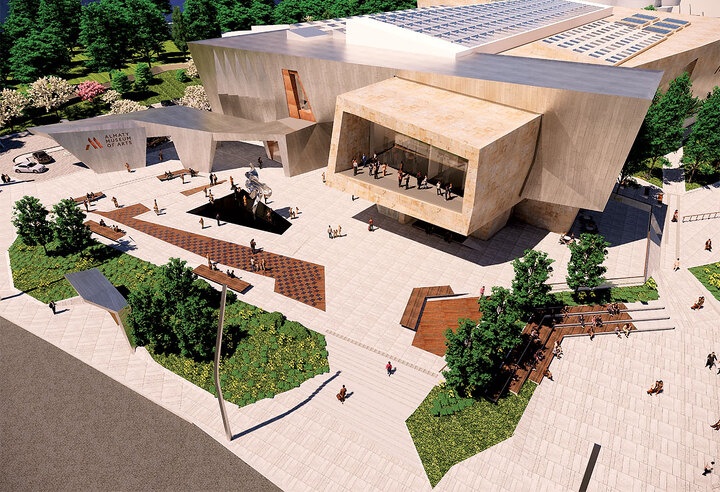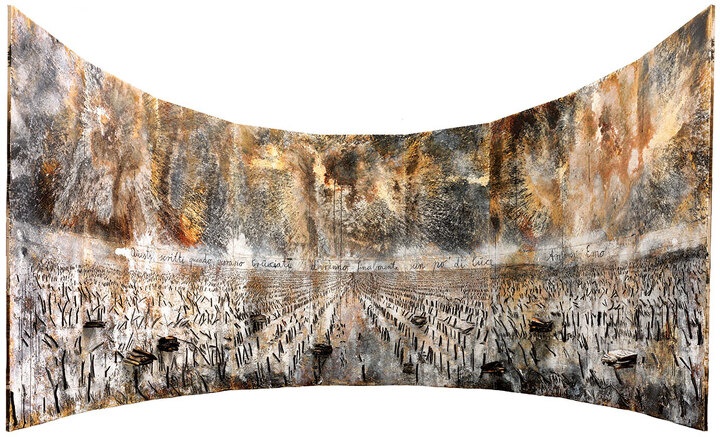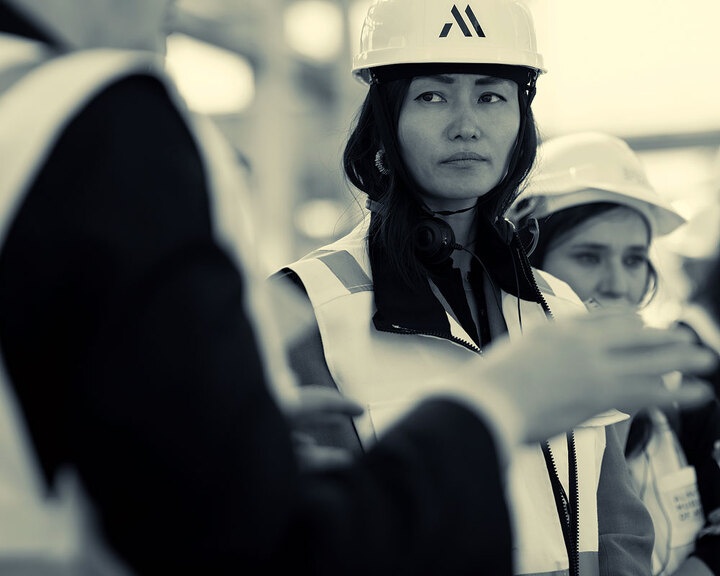How the Almaty Museum of Arts is taking its promising shape
The museum of contemporary art, which is due to open its doors in the autumn of 2024, is the first such facility in all of Central Asia

Photo: © Andrey Lunin
Gaining a stronger position for Almaty on the world art scene is a mission undertaken by the team constructing the Almaty Museum of Arts. In late September, the main investor of the project, Nurlan Smagulov (ranks ninth among the richest businessmen according to Forbes Kazakhstan), personally gave a media tour of the museum’s construction site.
The tour drew many people – and for good reason: the museum of contemporary art, which is due to open its doors in the autumn of 2024, is the first such facility in all of Central Asia. Along with the investor, Meruert Kalieva, an art critic and Director of Museum Activities at the Almaty Museum of Arts, and Chris Lanksbury, Regional Director at Chapman Taylor, the architect firm which designed the building, told reporters about the project.
Without Soviet classics
According to Smagulov, who regards the Almaty Museum of Arts as his favorite brainchild rather than just another investment, the new museum will play a special part in the cultural life of Almaty. The city still has no space to host large-scale exhibitions of leading contemporary artists. The A. Kasteev State Museum of Arts sometimes exhibits contemporary art, but its main direction is classics. “We don’t want to compete with the Kasteev Museum at all. It is much more powerful and appropriate in its composition,” says Smagulov.
The bulk of the Almaty Museum of Arts’ collection will be pieces of Kazakh art from the millionaire’s private collection. Some of these works will be displayed in the permanent exhibition hall. “We probably won’t hang Shardenov, Aitbaev (classics of the Soviet Kazakh fine art. – Editor’s note), but will select works created over the last 30–40 years,” says Smagulov. One of the Kazakh artists whose works will be displayed in the new museum is Rustam Khalfin, known for his experiments in contemporary art of the late 20th century. Perhaps the Almaty Museum of Arts will open with his exhibition.
All in one
The new museum is unlikely to have to compete with the existing cultural institutions in Almaty: its technical parameters meet the highest international standards (“triple A,” as Smagulov put it). The total usable floor area of the building is 8900 sq. m, and the exhibition area is 3600 sq. m. In addition to a storage space for 5000 works of art, there is a restoration workshop with high-quality equipment, a multifunctional transformable hall for concerts, film shows, theatrical performances and lectures, a workshop running educational programs for children and adults, an original bistro, and a gift and book shop.

Photo: press service archive
The engineering infrastructure of the museum is designed by Buro Happold, a British firm that worked on the Louvre Abu Dhabi, the Los Angeles County Museum of Art (LACMA), and the reconstruction of the British Museum in London. The building is engineered to allow any works to be displayed, ranging from very fragile to monumental and immersive ones. The museum will meet strict standards for temperature, humidity and lighting. “As for the storage space, it will consist of different areas because different pieces of art require different temperature and humidity conditions. A company from Lithuania has developed special shelving for us for compact storage of works,” says Smagulov.
Meruert Kalieva noted that the museum would gradually make its collection larger and more diverse. “Our museum will be fully prepared to store all kinds of materials,” she says. As an example, the art critic mentions the installation by Kazakh artist Erbosyn Meldibekov “Monument to an Unknown Hero,” which is already in the collection of the Almaty Museum of Arts. It consists of horse hooves soaked in formaldehyde. “This kind of installation needs special humidity conditions,” explains Kalieva. She calls photographs the most sensitive type of works. The museum will create all the necessary conditions for them too.
Against the backdrop of the city and mountains
The creators of the Almaty Museum of Arts strive to make it a landmark on the cultural map of the city and even the world. Smagulov likes to cite the example of Bilbao, a Spanish city that changed dramatically with the opening of the Guggenheim Museum, which holds one of the world’s best collections of contemporary art. Likewise, he hopes for changes to start to take place in Almaty, a city that obviously lacks modern cultural and exhibition space. Almaty residents are sure to take notice of the new museum when it finally comes into being. The very location of the building – the intersection of Nazarbayev and Al-Farabi Avenues – makes it noticeable.
Chris Lanksbury, who worked with Smagulov before (in particular, Chapman Taylor designed the MEGA shopping centers in Almaty and Astana), notes that the Almaty Museum of Arts is a unique facility that architects and engineers developed from the ground up, with the urban planning context and space multifunctionality in mind. “All of our buildings are unique technically and aesthetically,” says Lanksbury. “We don’t have boilerplate solutions. In this case, we tried to create something eye-catching and yet complex. It took a lot of effort for the architects to come up with the current form of the building.”

Chris Lanksbury
Photo: © Andrey Lunin
Lanksbury is confident that the museum will become an attraction of Almaty. The challenge for Chapman Taylor’s team was to blend the new building into the urban landscape. This purpose is achieved with a large atrium running through the museum. It visually and functionally connects the museum with the nearby Almaty Theater on the western side and Nazarbayev Avenue on the southeastern side. The atrium will make the new museum friendly to the city, Lanksbury said.
Since the building is located at the intersection of two busy avenues, the architects decided to create a facade that would at the same time contrast the museum with the chaos of cars going on around. With this in mind, the architects made the northern facade that overlooks Al-Farabi Avenue monumental, as if protecting the world of high art from the street. Lanksbury believes there is nothing wrong with this contrast; on the contrary, it enriches the experience of visiting the museum. “Sometimes, when looking at works of art, you find it nice to glance out of the window and see the hectic activity of the city,” he says. Several windows will offer views of the mountains – perhaps the main attraction of Almaty. In terms of diversity of visual experience, the Almaty Museum of Arts promises to be something special.
Another challenge facing the designers was to safeguard the stylistically expressive museum building from earthquakes. The facade has a lot of sharp corners, and protruding and overhanging elements. They make the museum stand out against the background of surrounding buildings and provide fine interplay with the peaks of the Alatau Mountains, Lanksbury believes. “We wanted the building to have an eye-catching and memorable shape. One of its highlights is external elements (for example, a terrace “floating” above the south-eastern entrance to give a view of the mountains. – The author’s note). It was a hard task to design them, while also ensuring seismic safety. I can praise engineers and other specialists who successfully addressed this challenge,” says the British architect.
Venetian adventures
While for Almaty residents the new museum will obviously become a landmark due to its architecture and cultural significance, the creators of the Almaty Museum of Arts plan to attract foreigners with an exhibition of works by leading world artists. The museum has already purchased several world-famous works (Smagulov refuses to disclose the cost of the works, joking, “If I reveal the cost, everyone will only talk about it, rather than the cultural value”). In addition, the museum plans to hold large temporary exhibitions at least twice a year.
One of the works purchased for the museum’s collection is the installation “These Writings, When Burned, Will Finally Cast a Little Light” by German artist Anselm Kiefer. Kiefer is known for his complex and controversial works exploring the themes of history, mythology, and the modern state of man. The artist devoted a lot of time to studying issues related to collective memory, national identity, and the role of man in history. Kiefer’s works, in which he likes to experiment with materials, often refer to fiction and philosophy.

Anselm Kiefer. These Writings, When Burned, Will Finally Cast a Little Light, 2022
Photo: press service archive
The installation “These writings, when burned, will finally cast a little light” was created by Kiefer for the 59th Venice Biennale. The series of works dedicated to the 1600th anniversary of Venice, as it were, reflects on the history of the city. Its name refers to the works of the 20th century Venetian philosopher Andrea Emo. Initially, the installation was exhibited in the Doge’s Palace, a monument of Gothic architecture located in St. Mark’s Square in Venice. When Smagulov saw the installation there in April last year, he got enthusiastic about the idea of buying it for the new museum. “This work was the title piece at the Venice Biennale,” he recalls. “The whole of Venice was decorated with its photographs.” Success seemed unlikely: the world’s major museums were eager to get the installation. The Kazakh businessman was lucky: through New York gallery owner Larry Gagosian, he met Kiefer himself and bought the installation for the Almaty Museum of Arts. “Other museums came after us, the Parisians really wanted this work, but they were told: the Kazakhs had already bought it,” Smagulov laughs.
The installation looks impressive even in the photo. Using different materials such as metal, acrylic, emulsion, wood, Kiefer reflects on the role of Venice in the world history and the relationship between classical and modern art. Like many other works by the artist, this one is open to interpretation, and the Almaty Museum of Arts team hopes that in Almaty it will have new meanings to impart.

Meruert Kalieva
Photo: © Andrey Lunin
Serra, a living classic of modern art, was one of the first artists to use industrial materials in his works. His multiton sculptures, which cannot be installed or moved without the author’s permission, often become places of pilgrimage for art lovers. “It’s not so easy to move it,” says Smagulov. “It weighs 155 tons.” Transportation of the sculpture from America to Almaty is estimated to take six months and installation – another month. It is shipped disassembled. The equipment necessary for installation will also be brought with the sculpture. Smagulov proudly says, “Museums are built for such things.”
The businessman believes Richard Serra’s Junction will become the hallmark of the museum. “It’s difficult to convey your feelings when you first see this work,” he says. “From the outside, the sculpture may seem quite simple, but when you get inside, completely unexpected views open up. An important element of this work is sound: the way it reflects from the interior surfaces of the sculpture.”
The museum’s collection recently added a piece by renowned Japanese artist Yayoi Kusama, known for her avant-garde works in a variety of genres, including painting, sculpture, installation, and performance. A series of installations that Kusama has been creating for several decades is called “Infinity Mirror Rooms.” The Almaty Museum of Arts purchased one of those rooms. Entering this room, which is called “Love is Calling,” visitors find themselves in a seemingly endless space that changes the boundaries of perception. The forms characteristic of “Infinity Mirror Rooms” are complemented by a sound track in which the artist recites her poem.

Richard Serra. Junction, 2011
Photo: press service archive
Visitors to the world’s leading museums line up to see the Infinity Mirror Rooms. The room purchased by the Almaty Museum of Arts is no exception. While the museum is under construction, the installation is on display at the San Francisco Museum of Modern Art, where Kusama is holding a solo exhibition. “We are so kind-hearted: there is nowhere to store it while the construction is underway, so we gave it away. The room will arrive here next autumn,” smiles Smagulov.
It seems that the artists whose names Smagulov and Kalieva pronounce with such reverence are little known to most Almaty residents, but this will soon change. The entrance fee charged by the museum will be quite affordable – 500 tenge. In addition to exhibitions, it will hold master classes for children and adults, theatrical performances, and concerts. The Almaty Museum of Arts expects to become a meeting place for Almaty residents and guests of the city. It has already received many offers of cooperation today. For now, Smagulov and his team prefer to have full control over the process of creating the new cultural institution, but in the future it will be open to collaborations, the creators promise.
Source: forbes.kz
